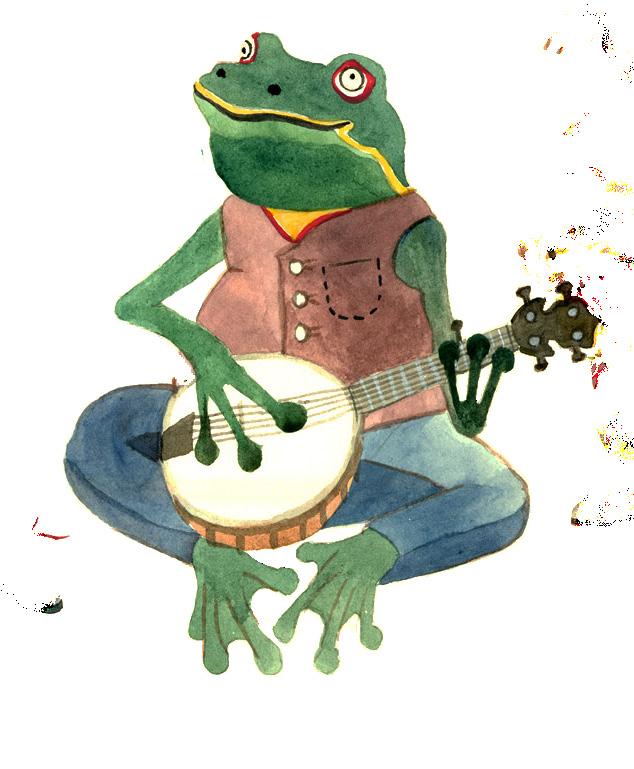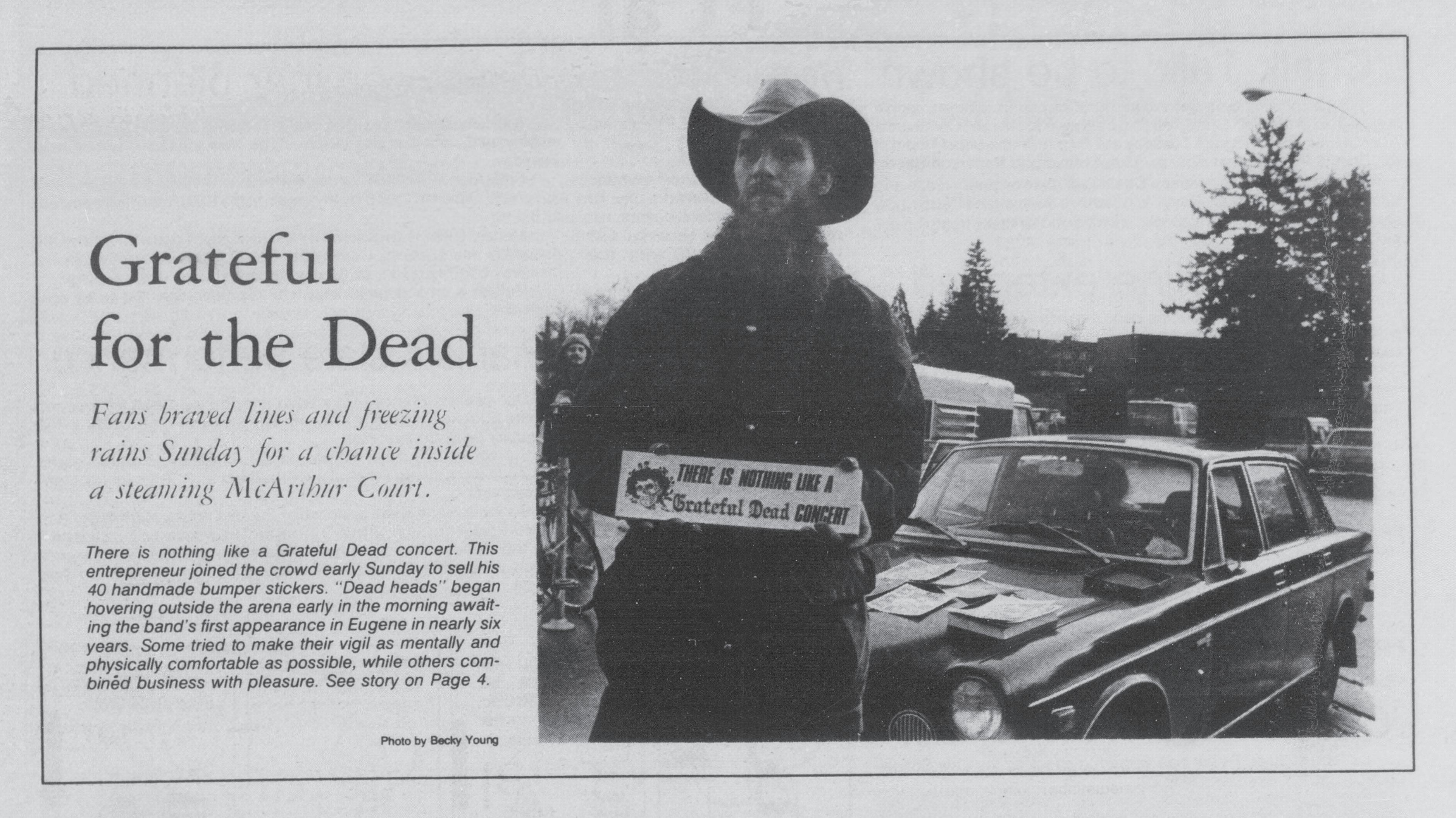






Grab the gear and make sure you’re ready to tie-dye out
Autzen Oct 25th ! Jersey available 10/24 — watch The Duck Store on social media for exact time.










GAMEDAY, the Daily Emerald’s football edition, is published by Emerald Media Group, Inc., the independent nonprofit news company at the University of Oregon founded in 1900.
EMERALD MEDIA GROUP 1395 University St., rm. 302 Eugene, OR 97403 541.346.5511 | dailyemerald.com
NEWSROOM
Editor in Chief Tarek Anthony
Print Managing Editor Ryan Ehrhart
Sports Editors
Jack Lazarus Owen Murray
Copy Chief Olivia Ellerbruch
Sports Writers Harry Leader Henry Light
Joe Krasnowski
Max Koebel Rachel McConaghie Rowan Shea
Photo Editor Saj Sundaram
Design Editor Adaleah Carman
Designers
Abigail Raike
Ellery Burton-Tillson
Eva Andrews
Maya Gooneratne

BUSINESS
President & Publisher
Eric Henry x317
Vice President, Operations
Kathy Carbone x302
Creative Technical Director
Anna Smith x327
ADVERTISING
Director of Sales and Digital Marketing
Shelly Rondestvedt x303
Account Executives
Torin Chevalier Camcole Pereira Ava Stephanian Elliot Byrne

(Left) Oregon Ducks tight end Kenyon Sadiq (18), Oregon Ducks tight end Jamari Johnson (9) and Oregon Ducks offensive lineman Isaiah World (76) celebrate after a touchdown. The University of Oregon Ducks opened their football season against the Montana State Bobcats at Autzen Stadium on Aug. 30 in Eugene, Ore. (Saj Sundaram/Emerald)
PLAYER
DANTE MOORE
AUSTIN NOVOSAD
MAKHI HUGHES
NOAH WHITTINGTON
MALIK BENSON
JUSTIUS LOWE
DAKORIEN MOORE
GARY BRYANT JR.
ISAIAH WORLD
EMMANUEL PREGNON
IAPANI LALOULU
CHARLIE PICKARD
DAVE IULI
MATTHEW BEDFORD
ALEX HARKEY
KENYON SADIQ
RS-SO/TR
JR/TR
SR/TR
SR/TR RS-JR
RS-SR/TR
RS-SR/TR
RS-SR/TR
RS-JR
RS-JR
RS-SR/TR
PLAYER
VINNY ANTHONY II
CHRIS BROOKS JR.
TRECH KEKAHUNA
JAYDEN BALLARD
RILEY MAHLMAN
JOE BRUNNER
DAVIS HEINZEN
KERRY KODANKO
EMERSON MANDELL
LANCE MASON
JACKSON ACKER
HUNDER SIMMONS
DANNY O’NEIL
DILIN JONES
DARRION DUPREE
CADE YACAMELLI
A’MAURI
TIONNE GRAY
MATAYO UIAGALELEI
TEITUM TUIOTI
BRYCE BOETTCHER
DEVON JACKSON
BLAKE PURCHASE
ELIJAH RUSHING
DILLON THIENEMAN
AARON FLOWERS
IFY OBIDEGWU
BRANDON FINNEY JR.
THERAN JOHNSON
PEYTON WOODYARD
DAYLEN AUSTIN
JAY’VIAR SUGGS
PARKER PETERSEN
DARRYL PETERSON III
CURTIS TACKETT
CHRISTIAN ALLIEGRO
COOPER CATALANO
RICARDO HALLMAN
D’YONI HILL
OMILLIO AGARD
AUSTIN BROWN
MATTHEW JUNG
MATTHEW TRAYNOR
GEIMERE LATIMER II

















Oregon’s new jerseys celebrate a long history between the band and the city of Eugene.
BY HARRY LEADER Sports Writer
The Oregon Ducks will debut their latest alternate uniform against the Wisconsin Badgers this weekend, which features tiedye Grateful Dead inspired logo. The collaboration is not random, though.
The uniform is a spin on their 2024 “Fly Era” uniforms with yellow and green tie-dye on the jersey numbers and logo on the back of the helmet. The helmet also features a twist on the Grateful Dead’s rainbow bears, with five different colored Oregon Ducks marching on the back.
The bear reference comes from the 1973 “Bear’s Choice” album, which featured different colored bears marching around the cover and has since become one of the band's standout logos alongside their main logo of a skull with a lightning bolt. The new jersey also features an alternative version of the skull where it is replaced with a duck, and the lightning bolt is shaped like the Nike Swoosh.
"As it's the Oregon tradition to be untraditional, this is just the latest example of the relationship between Nike and Oregon represented in a football uniform accompa-
nied by both player and fan off-field apparel," UO football equipment administrator Kenny Farr said to GoDucks. "We are grateful — pun very much intended — for the opportu nity to participate in this collaboration."
The band itself performed at Autzen Sta dium 10 times between 1974 and 1994, but their first performance at the University of Oregon took place in the EMU Ballroom in 1968. This performance was one of many concerts that the band held at universities during the Vietnam War protests.
The Grateful Dead also has ties with the local community. In 1972, they played a benefit concert to save Springfield Cream ery, which famous novelist Ken Kesey's family owned. The concert saved the busi ness and created a strong tie between the band and Eugene.
Fans are encouraged to participate in the “tie-dye out” at Autzen this Saturday in the matchup against the Wisconsin Badgers, which will kick off at 4 p.m. PST.
(ABOVE) Newspaper clipping from Jan. 23, 1978.
(University of Oregon Libraries) (RIGHT)
(Photo courtesy of GoDucks)






A look back at Oregon’s history of inconsistent kickers.
BY HARRY LEADER Sports Writer
For all the talent the Oregon Ducks have produced at quarterback, receiver and running back since the start of the College Football Playoff era, one position has remained a frustrating question mark: kicker. The Ducks have missed some major field goals recently, including the 2023 regu lar-season loss to Washington and the loss to Indiana at home this season.
Currently, Ducks kicker Atticus Sappington ranks No. 87 in the nation in field goal percentage and No. 46 in field goals per game, according to the NCAA.
In the entire history of Oregon football, there have been zero kickers to make the NFL – or any other professional league. Since 2010, the Ducks have had seven starting kick ers and only two have kicked over 80% on field goals. Cur rently, most top tier kickers are in the 85% to 100% range.
The most consistent kicker in recent history is Aidan Schneider, who played at Oregon from 2014 to 2017. He went 51-for-60 on field goals and 212-for-215 on extra points during his time with the Ducks. Schneider was also a third team All-American and first team Pac-12 All-Con ference in 2015.
Schneider was a walk-on at Oregon and earned a scholar ship after making over 90% of his field goals in his first two seasons. His longest career field goal was from 47 yards.
The only other kicker over 80% is Sappington, who is 22for-27 on field goals since he transferred to Oregon from rival Oregon State in 2024. In 14 games last season, he only missed two field goals, but has missed three in half as many games this season.
Sappington only had had seven field goal attempts during his time in Corvallis, where he made five of them. His lon gest field goal with the Ducks was from 42 yards out.
Head coach Dan Lanning has been supportive of Sap pington since he joined the Ducks.
“I told Atticus early on when he missed that extra point that you’re gonna have another opportunity to kick again for this team and it’s going to be the difference for us,” Lanning said at a press conference after the Boise State game last season.
Sappington would go on to make the game winning field goal at the end of the game against Boise State in his sec ond game with Oregon.
Camden Lewis was the Ducks kicker from 2019 to 2023 and left Oregon as the program’s all-time leading scorer with 408 points. Even with all of those points, though, he was inconsistent – 49-for-68 on field goals (72.1%). Lewis missed a potential game-tying field goal from 43 yards out in Oregon’s regular-season loss against Washington in 2023. Earlier that same game, he made his longest field goal of the season from 45 yards out.
Since 2010, the Ducks have made 152 field goals on 201 attempts, 76.8% overall. Looking at the eight programs who have won a national championship since 2010, five of them kicked at a higher rate than Oregon, and the ones who hadn’t over that period had kicked at a similar rate as the Ducks.
Currently the Ducks have four kickers on the roster, with redshirt freshman Gage Hurych looking like the po tential starter for next season.
Hurych, from West Linn, Oregon, missed his only attempt of the year against Rutgers, but is 12-for-12 on extra points this season. He was rated as the No. 13 best kicking prospect by 247Sports coming out of high school and the No. 16 kicker nationally by ESPN.
“ “
I told Atticus early on when he missed that extra point that you're gonna have another opportunity to kick again for this team and it's going to be the difference for us.
Dan Lanning Head Coach

(RIGHT) Oregon Ducks place kicker
Atticus Sappington (36) kicks the ball to the Nittany Lions after the Ducks score a touchdown. The University of Oregon Ducks played the Penn State University Nittany Lions at Beaver Stadium in State College, Pa. on Sept. 27, 2025.
(Saj Sundaram/Emerald)

BY JACK LAZARUS Sports Editor
It hasn’t been often that Oregon football head coach Dan Lanning has had to get his team ready for a bounce-back game.
In his four year tenure at Oregon, his teams have lost just seven games. Of those seven games, only four came with a game just the next week. In other words, Lanning hasn’t had to coach many real “bounce-back” games during his tenure.
This time the Ducks responded this time with a 56-10 thrashing at Rutgers.
Going into the week, however, doubt surrounded the program as it regarded whether the loss proved a weakness in the Ducks as a whole or if it was just group a of mistakes that compounded on themselves.
“I don’t think you look at the game and say everything’s broken,” Lanning said at his Monday press conference following the loss. “We lost to a really good team. We were tied in the fourth quarter and didn’t finish the game. Did we play our best game? No. But what success looks like, it looks like improvement.”
That improvement had to come during Rutgers week, as the middle of the season offers no respite for top squads in power conferences. The Ducks couldn’t afford to play down to the Scarlet Knights and cruise to an easy victory; they had to dominate.
On Tuesday of that week, senior wide receiver Malik Benson noted it wasn’t stats the team was chasing, but rather what has been repeatedly referred to as the “Oregon standard.”
“(We need to) go out there and do what we do,” Benson said. “The Oregon offense, explosive plays and things like that. What I want to see is everyone doing their 1/11th and everyone doing their job. Once everyone does their 1/11th, we can’t be stopped.”
Benson also spoke about Ducks quarterback Dante Moore, whose two late interceptions against Indiana proved costly in the loss.
“We ask quarterbacks to be the superhero and the Superman of the show. Everybody’s going to have a bad game, but if it’s about the quarterback, they either congratulate him or put the blame on him,” Benson said.
Moore, who had been criticized for his performance in the clutch against Indiana, stood out in New Jersey.
750 yards of total offense, 335 passing and 415 rushing, while also having the ball for five minutes less than the opponent likely helped put Moore’s name back into the good graces of those around the sport.
“When you have a tough week and a loss, you just have to take it as a lesson. I feel like when we attacked last Monday, (Lanning) had that confidence and trust in me still. As a player you love that, when your head coach has full 100% confidence in you,” Moore said to GoDucks after the win at Rutgers.
Moore himself posted a statline to prove that point a little bit further. The redshirt sophomore completed 15 out of 20 pass attempts for 290 yards and four touchdowns through the air. He also used his speed to his advantage for 49 yards on three attempts and avoided getting
sacked, which happened six times against the Hoosiers the weekend prior.
The Ducks converted on eight of 11 third downs, and a large part of that can be attributed to Moore’s elusiveness in and around the pocket – something he failed to display against Indiana.
“It was a tough loss; Indiana’s a great team, but we made sure this week we learned from our mistakes, pushed through the week Monday through Friday and I feel like the whole week we did a great job,” Moore said to GoDucks.
Moore’s ability to shrug off the loss and bounce back as aggressively and efficiently as he did against Rutgers is part of the reason his teammates have elite confidence in his ability to execute. Moore is a natural leader, and his approach to this bounce back game can be demonstrated by how he spoke to his team in the huddle.
“As an offense, I told them, ‘We need to smile and get back to the rhythm of play,’” Moore said to GoDucks.
Even after an early turnover led to Rutgers taking a 3-0 lead, Moore remained composed and focused on the job at hand. After all, he can only control his “1/11th,” as Benson would say.
As much as Moore and his teammates’ stats jumped off the page, the team echoes each other that the stats aren’t what matter.
“We’re not chasing stats; we’re chasing a standard,” Lanning said to GoDucks after the win at Rutgers.
That standard outdid itself. Going forward, the standard won’t change and the team will still be laser-focused on what comes next, and never what just happened. They’ll watch the film and clean up what needs to be cleaned, but that’s about as much rumination that goes into what happened.
The Ducks continue to focus on the future. But, as uncertain as the future may be at times, Lanning and his team control what they can control and move forward as if nothing happened – even after a major loss and especially after a major win.
“In football, rent’s due every week. As great as this win was, to see us accomplish to our standard what we want to be able to do, we gotta come into work next week again. It’s never gonna be easy,” Lanning said.
It’s clear that the fuel gained from losing a big game at home has not been exhausted at this point in the season. It’s only midway through the season, but the perspective forced on this team by that loss paid off against Rutgers and will only continue to pay its dividends as the Ducks go forward.
“It’s really not about what you’ve done for me lately, (it’s about) right now,” Lanning said.
(RIGHT) On October 11, 2025 the University of Oregon Ducks played the Indiana University Hoosiers at Autzen Stadium in Eugene, Ore. The Hoosiers defeated the Ducks 30-20. (Anna Liv Myklebust / Emerald)


Now that the Ducks have recovered from their first


Oregon saw a significant turnaround up front in its dominant win over Rutgers.
BY MAX KOEBEL Senior Sports Writer
The past two weeks told a tale of two games for the No. 6 Ducks. One week, they could not establish anything on the ground, and quarterback Dante Moore was constantly under pressure. The following game, they rushed for over 400 yards and four touchdowns.
After taking six sacks in the loss to Indiana, Moore did not get sacked all game in Oregon’s 56-10 win over Rutgers.
The Hoosiers held Oregon to 81 rushing yards with an average of 2.7 yards per carry and running back Jordan Davison’s 26-yard carry was the only rush for more than 10 yards. The Indiana defense finished the game with eight tackles for losses. Moore’s inability to escape the pocket left him with -27 rushing yards and -3 average yards per carry by the end of the game. His longest run of the game went for just four yards.
One week later, the Ducks’ offensive line flipped the script. After being unable to stop the Indiana pass rush or create holes for the running backs, the big boys up front came into Piscataway, New Jersey ready to work – and left with the number to show for it.
“We usually have protection,” running back Noah Whittington said to GoDucks postgame. “But we gave up six sacks last week and we really wanted to come out and improve in that area and we took the necessary steps this week to do that.”
Whittington had 11 carries for 125 yards with two rushing touchdowns and a receiving touchdown. His longest run was a 68-yard touchdown in the first quarter to give Oregon its first score of the game.
“Hell of a block by Jordan Davison and the big guys up front,” Whittington said to GoDucks. “I just had to run.”
The Ducks rushed for 415 yards, averaging 11.5 yards per carry. Whittington, Davison and Dierre Hill Jr. all rushed for touchdowns.
“We wanted to establish the run,” head coach Dan Lanning said to GoDucks. “We felt like we could move bodies up front and run through some arm tackles and we did that tonight.”
Moore also had a much cleaner game with the help of the offensive line. He ran for 49 yards on three carries, with his longest being for 35 yards. He also threw for 290 yards, just over 100 more than the week before, despite playing less than three quarters. Moore’s decision making improved without having to deal with a constantly collapsing pocket.
“It starts with (offensive line) coach (A’Lique) Terry,” Moore said to GoDucks. “He just dissected this defense really well. (He) understands the front they play in, understands how the linebackers flow and different ways to get different run games going. He did a great job preaching to the front
The Ducks aimed to create multiple holes on each play to offer options to ball carriers as a play was developing. Lanning spoke postgame about the process of how that breaks open explosive runs.
Lanning spoke postgame about the process of breaking open explosive runs. “Once a run opens big and then movement on the line. Several of our run plays had multiple options where the ball could go to a couple different spots based on where they were heavy or tilted and I thought our guys did a good job with that.”
The Ducks have shown tremendous depth in their running game this season, while Moore has demonstrated elite decision making in the pocket. This Saturday, the offensive line has another great opportunity to create success for the offense as Wisconsin comes to town. The Badgers have allowed just under 500 yards on the ground in their last three games. When matched up against Oregon, they will likely be faced with insurmountable numbers.
(BELOW) The Oregon offensive line huddle to decide on a play. The University of Oregon Ducks played the Penn State University Nittany Lions at Beaver Stadium in State College, Pa. on Sept. 27, 2025.








The Ducks have overcome the inexperience that impacted their preseason rankings.
BY HENRY LIGHT Sports Writer
Oregon crossed the halfway point of its season in a Week 7 loss to Indiana, offering an opportunity to answer some questions that lingered around the Ducks in season previews. Could the Ducks replace the production they lost to graduation and the NFL? Could Dante Moore run an elite offense? Would Makhi Hughes land in the top 10 in the nation in rushing yards again? Some of the answers are more finalized than others, but all have influenced evaluations of the Ducks’ first-half performances.
In a preseason press conference, defensive coordinator Tosh Lupoi described his unit as “Oregon inexperienced” as a way to acknowledge the mix of transfers and freshmen the Ducks would be leaning on to replace key players they lost to graduation and the NFL. The amount of roster turnover and uncertainty about the players’ ability to adapt to playing at Oregon were significant contributors to the Ducks’ slide from No. 3 in last year’s preseason AP Poll to No. 7 entering this year. So far, that 11-player transfer class has filled key gaps on Oregon’s roster, with some forming position groups that have the chance to improve on their 2024 counterparts. Their rapid adaptation has been a success story for Dan Lanning’s handling of the transfer portal.
Safety Dillon Thieneman, cornerback Theran Johnson and nickel cornerback Jadon Canady have helped Lupoi replace nearly the entire secondary from 2024. Additionally, defensive lineman Bear Alexander has been a steady contributor to Lupoi’s pass rush, recording 28 tackles, including 4.5 for loss, and half a sack.
On the offensive side, wide receiver Malik Benson has done what Lanning brought him in to do: be a safety net for a very young wide receiver room. Benson has seen the third-most targets among wide receivers and taken them for 277 yards and three touchdowns.
Oregon’s overhauled offensive line has garnered some criticism, especially following a six-sack performance against Indiana, but neither Alex Harkey, Isaiah World or Emmanuel Pregnon have stood out on their own. Considering the unit lost all but one starter in the offseason, the three transfers have been a positive up to the mid-point of the season, although that could change if they continue to struggle against better competition.
Moore’s first half is also somewhat clouded by the Indiana game, especially his two fourth-quarter interceptions, but his performance against Penn State lessens the concern about big games. More than anything, Moore’s ability to improvise outside the pocket was remarkable considering his lack of experience. It was exemplified on the game-winning touchdown when defensive end Dani Dennis-Sutton nearly blew up the play-action call, but instead Moore sidestepped him and found Gary Bryant Jr. wide-open 20 yards downfield.
Following Oregon’s win over Rutgers, Moore sits tied for second in the Big Ten in passing touchdowns with 19, fifth in completion percentage at 72.3% and ninth in passing yards with 1686. It has been an excellent start considering his spot wasn’t guaranteed, however exaggerated the preseason quarterback battle may have been.
While Lanning brought in transfers to fill holes on his inexperienced roster, he also relied on several highly-touted freshmen to make an immediate impact. It was a valid concern in trying to determine the Ducks’ ceiling preseason, since there was no true way to evaluate them, but several of the freshmen have taken advantage of their opportunities.
According to cornerback Brandon Finney Jr., the opportunity for freshmen was attractive as a recruit.
“Yeah, (a starting role was) a unique opportunity that was presented to me, obviously, in recruiting. (Defensive backs coach Chris Hampton), he was just

like, ‘I mean, everybody’s young, it’s up to you if you’re going to work to take it,’” Finney said in an Oct. 15 press conference.
Dakorien Moore has broken out as not only Oregon’s number-one receiver ahead of senior Gary Bryant Jr., who presented a safer option pre-season, but as one of the best freshmen in college football. Dakorien Moore has totaled 398 receiving yards and three touchdowns through Oregon’s game against Rutgers. He currently sits at No. 17 in the Big Ten in receiving yards and No. 11 in yards per reception with 15.9.
The running back room was a less obvious opportunity for freshmen to win roles, with Noah Whittington, Makhi Hughes and Jayden Limar expected to take a significant chunk of the carries, but that didn’t stop Davison and Hill from seizing carries. Hughes came in with high expectations after finishing No. 10 in the nation in rushing yards last season at Tulane University, but after he failed to earn a role in camp, Davison and Hill putting up performances that warranted more carries was the final nail in the coffin for his 2025 season, and he decided to utilize a redshirt.
In Oregon’s two biggest games of the season to date, a freshman was leaned on as the leading rusher, with Hill taking 10 carries against Penn State and Davison taking eight against Indiana. Limar still leads the room in carries, and Whittington in rushing yards and touchdowns, but the two freshmen have already evolved from entering blowouts as depth pieces to being turned loose if they’re hot.
The Ducks continue into the second half of their schedule at home against a lowly Wisconsin team (2-5, 0-4 Big Ten) on Oct. 25.
(ABOVE) Oregon Ducks running back Jordon Davison (0) celebrates his touchdown, flapping his hands in the air like a duck. The University of Oregon Ducks played the Penn State University Nittany Lions at Beaver Stadium in State College, Pa. on Sept. 27, 2025.
(Saj Sundaram/Emerald)
The Badgers enter Autzen Stadium looking for their first points in three weeks, desperate for a slice of hope.
BY OWEN MURRAY Sports Associate Editor
A season ago, Wisconsin had the chance to derail a perfect season. A season ago, undefeated Oregon entered Camp Randall Stadium and walked out with a 16-13 victory decided in the fourth quarter. Dillon Gabriel converted a crucial fourth down to tight end Terrance Ferguson, and Matayo Uiagalelei sealed the win with a tip-drill interception. A season ago, Wisconsin was close.
This season, the Badgers, who own the nation’s thirdmost difficult schedule, are kingmakers in the Big Ten –or, at least, they could’ve been.
On Saturday, Oregon (6-1, 3-1 Big Ten) will encounter a Wisconsin (2-5, 0-4 Big Ten) team riding the bottom of the conference, on its third-string quarterback and a shadow of the one that posed it a real threat in 2024. The Badgers are winless in five straight entering Week 9 and struggling on both sides of the ball. Head coach Luke Fickell’s program has already faced then-No. 20 Michigan and No. 1 Ohio State, and will take on No. 2 Indiana and No. 23 Illinois back-to-back in November.
Since its two season-opening nonconference victories, Wisconsin has struggled in conference play, where it remains winless ahead of Saturday’s matchup with Oregon. It hasn’t scored a touchdown since the first quarter of its Week 6 loss to the Wolverines and has no points in its last two games.
A defense averaging 341.9 yards of total offense per game against, too, hasn’t helped. The Badgers’ leading tackler from 2024, Hunter Wohler, was picked by the Indianapolis Colts in the seventh round of the 2025 NFL Draft and while they’re 14th nationally in rushing yards against per game, it’s mostly because they’re leaky on the back end, where they allow 8.2 yards per pass (112th in FBS).
After starting quarterback Billy Edwards Jr. suffered a sprained knee in Wisconsin’s Week 1 win over Miami University (Ohio), time under
center has largely been split between Danny O’Neil, a sophomore who transferred to Madison from San Diego State before the season and won the starting job, and Hunter Simmons, a senior who logged his first game action this year. Neither has been efficient. O’Neil has thrown five touchdowns and five interceptions, and was replaced by Simmons following the Badgers’ Week 4 27-10 home loss to Maryland.
In the three games where Simmons has thrown at least 12 passes, Wisconsin hasn’t looked much better – albeit against stronger opposition. After a 24-10 loss at Michigan where he logged 177 passing yards and an interception, the offense was shut out in back-toback losses to Iowa (37-0) and Ohio State (34-0). Simmons tossed a pair of picks against the Hawkeyes and one last week against the Buckeyes. It’s not clear whether Edwards will return this season and Fickell was noncommittal about his quarterback’s timeline following the loss to Ohio State. It’s not much better on the ground, where the Badgers rank 122nd among the 136 FBS teams in rush yards per attempt, with 3.1. Sophomore Dilin Jones leads in attempts (76), yards (300) and touchdowns (two), but no other Badger has more than 169 yards. Darrion Dupree and Cade Yacamelli complete the room, and neither has a score this year.
The five-game slide that delivers Wisconsin to tie-dyed Autzen Stadium began with a 38-14 loss to Alabama (the second of a home-and-home that began in 2024), before the Badgers entered conference play with a 27-10 loss to Maryland, which was O’Neil’s last game. Since, they’ve dropped to Michigan before the back-toback shutouts against Iowa and Ohio State, and enter Eugene searching for salvation in a season that they’re trying to prove hasn’t been completely lost yet.
When the Ducks are in a close game, it’s usually thanks to the opponents use of the run game.
BY ROWAN SHEA Sports Writer
The Ducks play strong football. Their offense is explosive, they have a secondary that has excelled so far this season and because of it they’ve only lost one game. But Oregon has an issue that has been exploited since it left the Pac-12: it struggles to defend the run game.
Despite covering the rushing game well in the Pac-12, one game stands out. Under then first-year head coach Dan Lanning in 2022, the Ducks suffered a regular season-ending loss resulting from the breakdown of the defense against Oregon State. Every single play Oregon State ran following an Oregon field goal late in the fourth quarter was a rush.
The Beavers ran the same concept nearly every time they touched the ball: Pitch it out and hand it off to Damien Martinez, Jam Griffin or Deshaun Fenwick. The Oregon defensive line, whether there were four or five up front, did not close gaps well, and the linebackers crashed in the wrong places.
The Big Ten has always been known as the conference that focuses on smashmouth football. The Ducks embraced that format in their first year in the conference, when in 2024 they were ranked top-10 in rushing amongst FBS teams, ranking sixth ending the season at 2,211 rushing yards. The five teams that bested the Ducks – Penn State, Iowa, Rutgers, Ohio State and Indiana – are all traditional Midwest powers.
Despite the high ranking the Ducks held on offense, they did not uphold that on the other side of the ball. In the playoffs, Ohio State broke through Oregon’s defensive line as often as it could. In the Big Ten Championship game, Penn State had seven less attempts, 34, but
excelled, ripping off just under 300 rushing yards despite the loss. Both teams matched, and surpassed Oregon in size leading to the Ducks having a rough time getting around or through both offensive lines.
This season, the woes against physically larger teams have continued. The Ducks play well against smaller competition and are placed just below the middle of the Big Ten in rush defense because of that.
Already this year, Penn State and Indiana have exploited the lack of rushing defense in big games. The Nittany Lions had 35 attempts and 139 yards securing multiple touchdowns set up by the run game. Penn State’s only touchdown in overtime was on a run where Oregon collapsed. Tionne Gray was the closest to getting his hands on running back Kaytron Allen, but he was blocked well and tripped trying to get to Allen.
Teitum Tuioti had the same issue as Gray, but Tuioti did not have to break through the line to barely miss Allen, he had to spin off the defender, something he did too late and fell to the ground watching Allen go past. The secondary crashed once they saw Allen breaking to the side of the field, but Penn State offensive lineman Olaivavega Ioane swept across the line and pancaked Aaron Flowers and Bryce Boettcher. All Allen had to do was hurdle a body and he was in the endzone.
On Oct. 11, the Hoosiers had 37 attempts for 111 yards. Seven more attempts than Oregon had, and 30 more yards. Indiana stopped the Ducks’ defensive line with ease. The pressure rarely got to the Hoosier running backs. Indiana lined up well on each play, and ran the same play that Penn State did, pulling an offensive lineman across the formation to block an Oregon defender coming in on the side.
In the waning seconds of the first quarter, Indiana gave the ball to Roman Hemby. Hemby got a lane thanks to the Hoosier line stuffing everyone at the line of scrimmage. Hemby had to get past Bryce Boettcher who had a tackle lined up. Hemby lowered his shoulder and ran right through Boettcher for a touchdown. It was size-on-size and Indiana won.
Though it was a much needed bounce-back performance against Rutgers, where the Ducks allowed 123 yards, they need to show that they can take care of business against stronger teams. After all, Rutgers is ranked 12th in rushing in the Big Ten.
The games that Oregon played against less developed and effectively smaller teams are exactly what it wants to see: a strong defense breaking through and getting into the back field quickly, or minimizing the yardage running backs get past the line.
The true tests are coming up when Oregon takes on Iowa, Washington and USC, all top-half Big Ten teams running the ball. These games act as a preview to Oregon’s postseason: they’ll provide a clue to whether the Ducks can battle against tougher opponents and their rushing game, or if the struggle to get past the bigger bodies in front and pressure the run game up front will continue to rear its head.
(BELOW) Penn State Nittany Lions running back Kaytron Allen (13) scores a touchdown after successfully evading all of the Ducks’ defense. The University of Oregon Ducks played the Penn State University Nittany Lions at Beaver Stadium in State College, Pa. On Sept. 27, 2025.
(Saj Sundaram/Emerald)







Ducks are still mighty different.
BY JOE KRASNOWSKI Senior Sports Writer
In Eugene, as in most college-football-mad cities, there are 12 one-game seasons.
Still, No. 8 Oregon’s (6-1, 4-1 Big Ten) 56-10 win over Rutgers (3-4, 0-4 Big Ten), at SHI Stadium, was about as reassuring as a single game can be.
The offense clicked once again, the defense gelled and Dante Moore looked like one of the best quarterbacks in the country.
“All week we talked about operating to our standard. There are still some moments that we’ll want back from that game, but overall, I thought our players really attacked that,” Lanning said to GoDucks. “Regardless of what time it was in the game, who was on the field, these guys went and attacked, which is great. We talk about strength in numbers, and we had that tonight as well.”
Saturday was a good reminder that Oregon can still pack a punch like few others in college football can. Moore was out of the game by the end of the third quarter, finishing with 290 passing yards and four touchdowns, two of which came on highlight-reel grabs from Kenyon Sadiq.
Now this doesn’t mean that Oregon isn’t fixed or that any of the problems from the Indiana game won’t resurface.
Instead, let it serve as a reminder that, in this current college football landscape, no team is immune from bad days. lAlthough Oregon often makes it look easy, winning conference games is still really difficult.
One game is just one game, but any fan worried about some kind of let-up or rough response to a Week 7 loss to Indiana hasn’t been paying close enough attention to Oregon’s identity under Lanning.
“I was expecting our players to play with an edge,” Lanning said to GoDucks. “I was expecting them to execute and do their job at a really high level. I thought the things that we were asking our guys to do, that they were
The 12th Duck Effect.
RACHEL MCCONAGHIE Sports Writer
The University of Oregon’s Autzen Stadium might be small by Big Ten standards, but don’t let the numbers fool you. What it lacks in square footage, it makes up for in acoustic volume. According to USA Today, Autzen Stadium is ranked No. 6 in the top 10 loudest college football stadiums, with a record of 127.0 dB.
Before the start of the 2002 season, 12,000 seats were added to the south rim of the stadium per Collegegridirons.com. This addition added a cantilevered roof to cover fans seated in those sections from inclement weather. Though its capacity has increased to 54,000, Autzen is still smaller than all but five home stadiums in the 18team Big Ten Conference, with three nearly double its capacity – Michigan’s Michigan Stadium (107,601), Penn State’s Beaver Stadium (106,572) and Ohio State’s Ohio Stadium (102,780).
probably the best stadium I played in last year.”
The decibel record of 127.0 dB is only just short of the decibel record in College Football history of 137.0 dB at Neyland Stadium, home of the University of Tennessee. The advantage for the Volunteers is sheer size — a whopping 101,915 capacity, nearly twice the size of Autzen Stadium.
Even with a rowdy crowd at home, the Ducks faced an upset in their first loss at home in two seasons by the then-No. 7 Indiana Hoosiers. The defeat marked a new feeling on an otherwise dominant home record and a reminder that noise alone isn’t enough. Oregon head coach Dan Lanning, who has a 41-7 record with Ducks in his fourth year with the program, has long relied on what the crowd has to bring.
Lanning led Oregon to an undefeated home schedule in both 2023 and 2024, consecutively while playing in front of four of the 14 largest crowds in Autzen history. Oregon’s undefeated stint included a pivotal program comeback win over the Buckeyes in 2024.
able to do, and they did that tonight.”
Some history was made along the way. Oregon extended the nation’s longest road winning streak to 10 games while improving to 7-0 in Big Ten regular season games on the road.
Now, Rutgers has been among the lowly of the Big Ten for quite some time and has maybe a tenth of the overall talent that Lanning has on his roster.
But the Ducks can only play their opponent, and 750 yards of total offense is a truly eye-popping number.
Much of college football today is peaking at the right time, with Ohio State –which lost two regular season games last season before looking invincible in the playoff – only the most recent example.
Tasting its own blood might just be a good recipe for an Oregon team that will look to create similar success late in the season. We can expect the Ducks’ defense to travel wherever it goes, but creating offensive success like Saturday will be key going forward.
One big reason for Oregon’s success was the Ducks’ offensive line rebounding from a six-sack showing to leave Moore untouched.
“I think it starts with coach Terry. Coach Terry is the greatest offensive line coach in the country and in the world.” Moore said to GoDucks.
Oregon may not be the greatest team in the country right now, but they are still among the most talented, and on days like Saturday, that can be more than enough.
(ABOVE) Indiana Hoosiers linebacker Isaiah Jones (46) and Indiana Hoosiers defensive back D’Angelo Ponds (5) make an attempt to stop Oregon Ducks wide receiver Dakorien Moore (1) and he prepares to take the ball up the field. The University of Oregon Ducks played the Indiana University Hoosiers at Autzen Stadium in Eugene, Ore. on Oct. 11, 2025.
(Anna Liv Myklebust/Emerald)
But what it lacks in size, it makes up for with acoustics that turn crowd noise into an overwhelming environment.
Built like a giant bowl with the field set below ground level, the stadium has just one tier of seating that is both steep and close to the sidelines. The design of Autzen alone creates minimal sound escape. Instead of dispersing the crowd noise, it bounces off concrete and steel, hindering visiting teams’ on-field player communication.
In its second season in the Big Ten, Oregon’s home-field advantage has drawn attention from new opponents. After the Ducks went undefeated at home last season, it was clear that Autzen’s atmosphere had something special. Ohio State sophomore receiver Jeremiah Smith praised the atmosphere at Big Ten Media Days after experiencing it firsthand.
“It was rocking, probably the loudest I’ve ever been in,” Smith said to Oregon Ducks on Sports Illustrated. “The fans were definitely getting hyped. (I) couldn’t hear anything,
“Playing here at home, at Autzen, it gets really loud here as well, but everyone loves it when the fans are quiet for you when you’re on offense,” Oregon quarterback Dante Moore said. “The fans are on your side and there’s not much rowdy noise.”
Still, Oregon’s fans remain an active part of the equation. Rattling the opposing quarterbacks and forcing miscommunications continue to define the Autzen experience. As the Ducks navigate their second season in the Big Ten, the 12th Duck remains a critical factor. While other stadiums may host larger crowds, few have the passion of Duck fans.
(BELOW) Stands filled during the Oregon vs. Indiana game. The University of Oregon Ducks played the Indiana University Hoosiers at Autzen Stadium in Eugene, Ore. The Hoosiers defeated the Ducks 30-20 on Oct. 11, 2025.
(Anna Liv Myklebust/Emerald)

